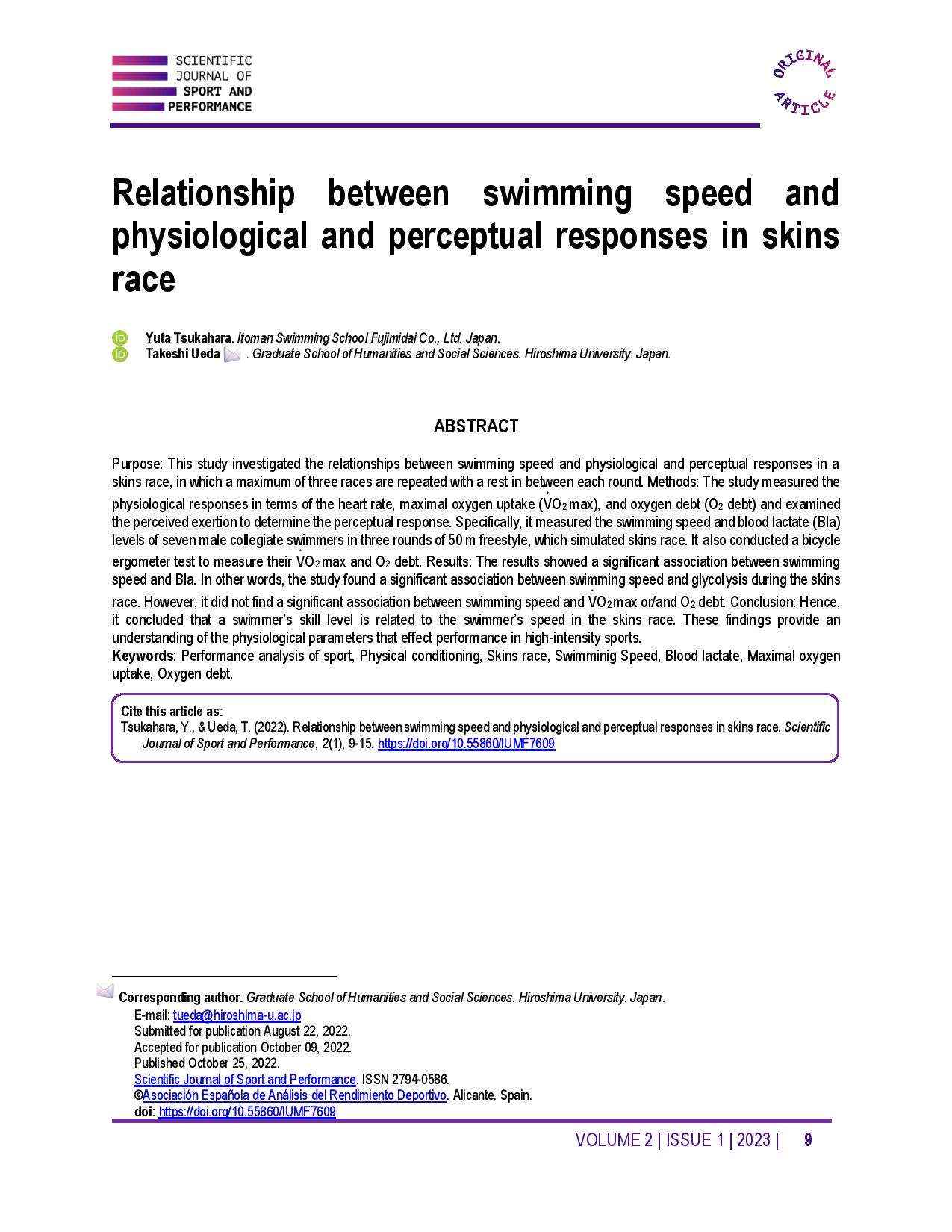Relationship between swimming speed and physiological and perceptual responses in skins race
Main Article Content
Abstract
Purpose: This study investigated the relationships between swimming speed and physiological and perceptual responses in a skins race, in which a maximum of three races are repeated with a rest in between each round. Methods: The study measured the physiological responses in terms of the heart rate, maximal oxygen uptake (VO2max), and oxygen debt (O2 debt) and examined the perceived exertion to determine the perceptual response. Specifically, it measured the swimming speed and blood lactate (Bla) levels of seven male collegiate swimmers in three rounds of 50 m freestyle, which simulated skins race. It also conducted a bicycle ergometer test to measure their VO2max and O2 debt. Results: The results showed a significant association between swimming speed and Bla. In other words, the study found a significant association between swimming speed and glycolysis during the skins race. However, it did not find a significant association between swimming speed and VO2max or/and O2 debt. Conclusion: Hence, it concluded that a swimmer’s skill level is related to the swimmer’s speed in the skins race. These findings provide an understanding of the physiological parameters that effect performance in high-intensity sports.
Article Details

This work is licensed under a Creative Commons Attribution-NonCommercial-ShareAlike 4.0 International License.
References
Cureton, T. K. (1951) Physical fitness of champion athletes, Urbana Univ. of Illinois Press: Illinoi, pp.314-350.
Dixon, R. W. and Faulkner, J. A. (1971) Cardiac output during maximal effort running and swimming, J. App1. Physiol., 20: 653-656. https://doi.org/10.1152/jappl.1971.30.5.653 DOI: https://doi.org/10.1152/jappl.1971.30.5.653
Hatta, H. (2009) Lactate and Exercise Physiology and Biochemistry: Energy Metabolism, Ichimura Press; Tokyo, 63. (in Japanese).
Holmer, I. (1972) Oxygen uptake during swimming in man, J. Appl. Physiol., 33: 502-509. https://doi.org/10.1152/jappl.1972.33.4.502 DOI: https://doi.org/10.1152/jappl.1972.33.4.502
Holmer, I., Lundin, A. and Eriksson, B. 0. (1974) Maximal oxygen uptake during swimming and running by elite swimmers, J. App1. Physiol., 36: 711-714. https://doi.org/10.1152/jappl.1974.36.6.711 DOI: https://doi.org/10.1152/jappl.1974.36.6.711
Kurokawa, T. Togashi, T., Nomura, T. and Ikegami, H. (1985) Relationship between swimming performance and maximal oxygen debt, maximal oxygen uptake, and oxygen requirement, Jap. J. Phys. Educ., 29(4): 295-305. (in Japanese). https://doi.org/10.5432/jjpehss.KJ00003392164 DOI: https://doi.org/10.5432/jjpehss.KJ00003392164
Magel, J. R. and Faulkner, J. A. (1967) Maximal oxygen uptake of college swimmers, J. App1. Physiol., 22: 929-933. https://doi.org/10.1152/jappl.1967.22.5.929 DOI: https://doi.org/10.1152/jappl.1967.22.5.929
McArdle, W. D., Glaser, R. M., and Magel, J. R. (1971) Metabolic and cardio-respiratory response during free swimming and treadmill walking, J. Appl. Physiol., 30: 733-738. https://doi.org/10.1152/jappl.1971.30.5.733 DOI: https://doi.org/10.1152/jappl.1971.30.5.733
Miyashita, M. (1970) Science of Swimming, Kyorin Shoin; Tokyo, pp.72-81. (in Japanese).
Sakai, K., Sheahan, J., Takamatsu, K. (1999)The relationship between high power output during intermittent exercise and three energy delivery systems, Jap. J. Phys. Fitness Sports Med., 48, 453-466. (in Japanese). https://doi.org/10.7600/jspfsm1949.48.453 DOI: https://doi.org/10.7600/jspfsm1949.48.453
Shephard, R. J., Godin, G. and Campbell, R. (1974) Characteristics of sprint,medium and long distance swimmers, Eur. J. Appl. Physiol., 32: 99-116. https://doi.org/10.1007/BF00421569 DOI: https://doi.org/10.1007/BF00421569
Yamamoto, M. and Kanehisa H. (1990) Mechanical power outputs of maximal intermittent exercise in relation to anaerobic and aerobic working capacities, Jap. J. Sports Sci.,9: 526-530. (in Japanese).




